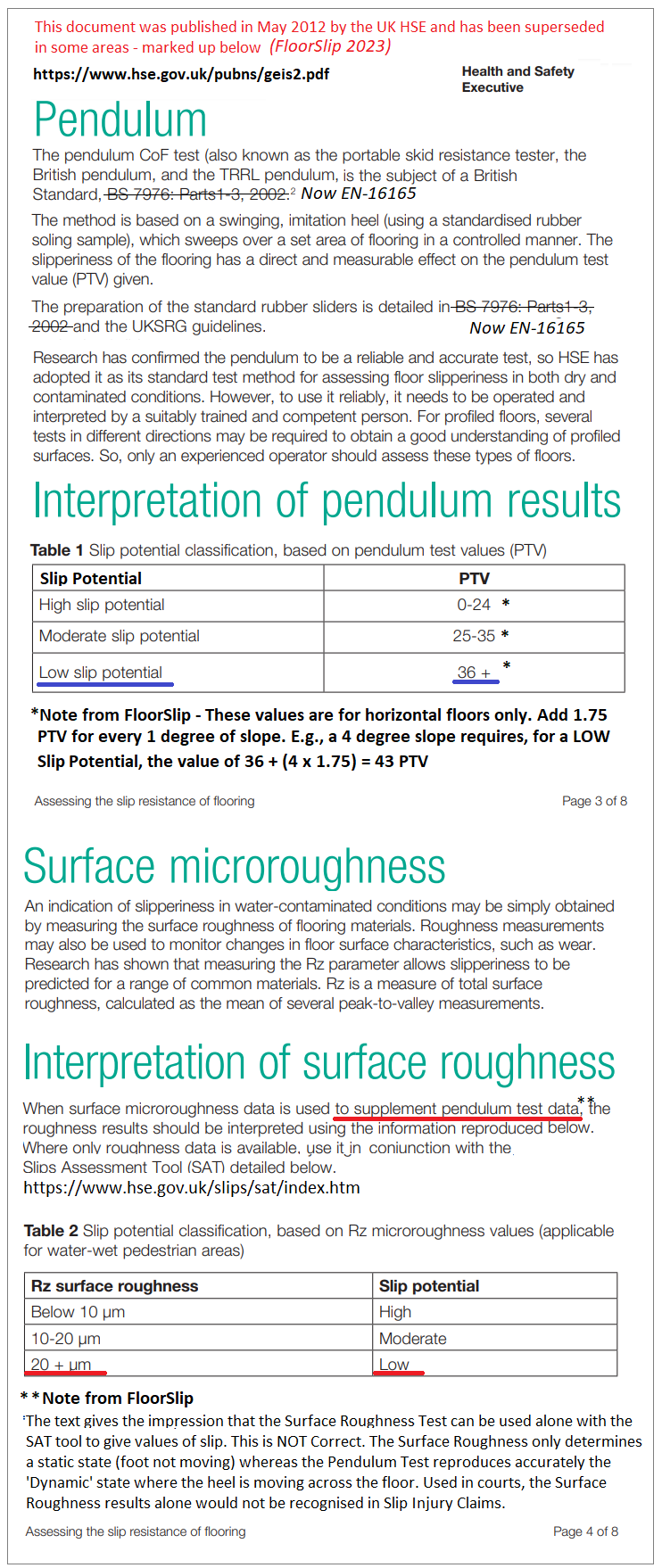UK Laws on Floor Safety
The quotes below are summarised extracts taken from 2 references the UK. GOV Legislation in respect to Floor Safety
REF 1 – HSE Guidance on the causes and prevention of flooring slips and trips
REF 2 – The UK Workplace Health, Safety & Welfare 1992 Regulation 12 (Flooring)
The UK Gov Health and Safety Requirements on Floors state (in summary)...
- Each floor workspace or traffic route shall be constructed in a suitable manner for the purpose for which it is used / work activity taking place on it
- All floors shall be in good condition, having no hole or trip hazard, not uneven and be free from obstructions.
- Floor slopes will be constructed to give extra slip resistance and consideration given for hand rails
- Stairs should have handrails
Expanding on the requirements of Floor Safety
Unfortunately, the two UK government / UK HSE refs above go into no real world detail leaving the reader guessing what to do next!
It’s no wonder there are so Slip Injury Claims.
They do however give these piece of detail (not easily found on the HSE Website) at https://www.hse.gov.uk/pubns/geis2.pdf (Even though the HSE mark the tab as 'Asbestos Licence Assessment'!)

May we therefore ask you to consider the three following suggestions on meeting the UK Laws on Floors...
Suggestion 1 – Read the section we have created on Buying / Specifying Floors
It goes into depth on what you should be doing - an if in doubt Contact FloorSlip
Suggestion 2 – Use Building Regulations in respect to Floor Safety
The Building Regs are also a bit ‘grey’ and non- prescriptive in places leaving the reader again ‘guessing’ what non-slip actually means and what values should be used. The Building Regulations we suggest to consult are: -
Part K - Protection from falling, collision and impact
Part M - Access to and use of buildings – Volume 1 – Dwellings
Part M - Access to and use of buildings – Volume 2 - Buildings other than dwellings.
Suggestion 3 – Consider other sources of floor slip data as listed below:
Item 1 - Assessing the slip resistance of flooring
https://www.hse.gov.uk/pubns/geis2.pdf
A brief (8 Page) overview of floor slips and discusses the Floor Pendulum Tests, Surface Roughness Tests and Ramp Tests
Item 2 – Safer surfaces to walk on, CIRIA (C652F)
ISBN: 978-0-86017-652-7
Authors: Lazarus, D, Perkins, C, Carpenter, J
Number of pages: 254 (free PDF)
Publisher: CIRIA
Date of Publication: January 2006
This is a FREE DOWNLOAD (Don’t pay for it, simply follow the instructions on the CIRIA site) A
This CIRIA guide has been produced as part of the Health and Safety Commission's programme to reduce the number of slips and trips accidents in the UK. It is an attempt to give practical guidance to those who design, procure and manage flooring in buildings and is based upon many research projects undertaken, primarily by the UK Health and Safety Laboratory.
Item 3 – On Line Learning (Paid courses) for managers and supervisors in floor safety, slips and trips
https://www.virtual-college.co.uk/resources/slips-and-trips
The HSE offer in conjunction with an on-line provided 3 courses at £25 each (2023) (Intro, Intermediate and Advanced) into the causes for slips, trips and falls; how they can be reduced; how to deal with them should they happen.
Item 4 – Other HSE Slips and trips Data
https://www.hse.gov.uk/slips/index.htm
Which has links to
- Understanding what causes slips and trips and how to prevent them
- Finding out what you can do in your role to prevent slips and trips
- Case study examples of solving common slip problems
- Publications, tools, research